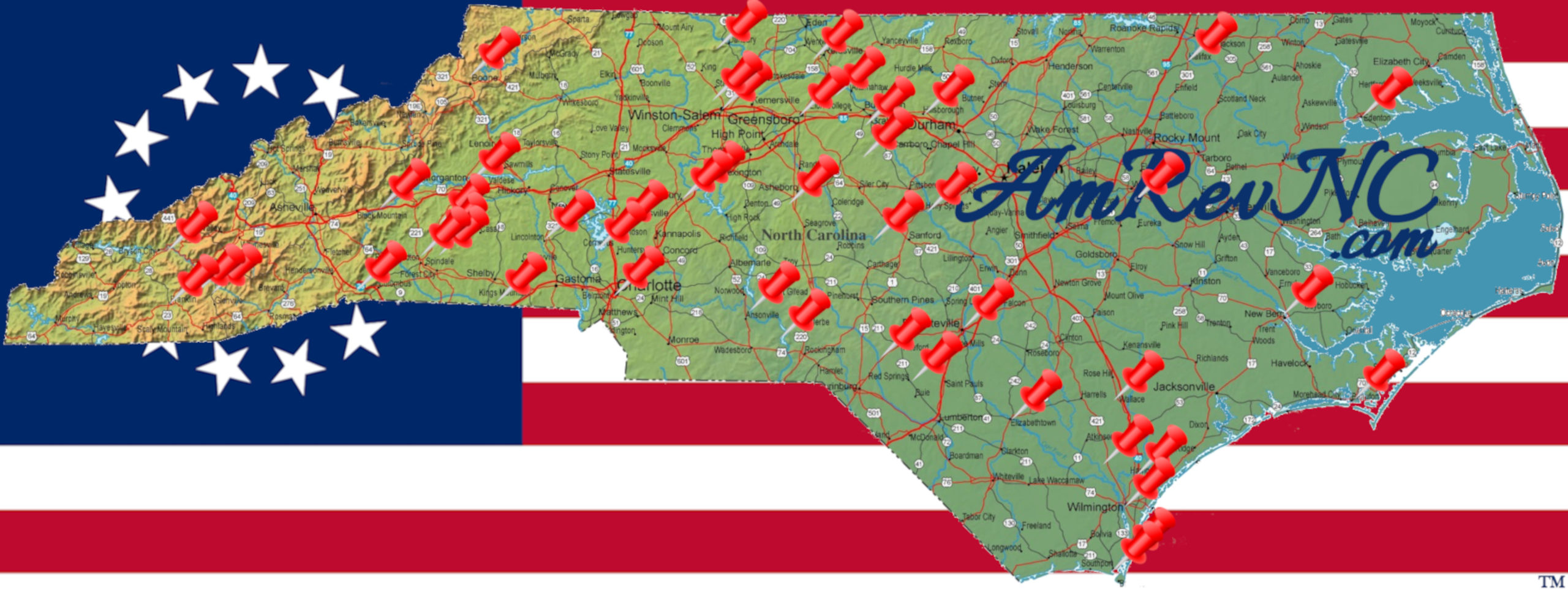No Taxation without Representation
Location
Type: Hidden History
County: Anson
![]() None
None
The site of the Anson County Courthouse before and during the American Revolution, and the grave of a Patriot militia officer, lie out of sight behind a locked gate on private game lands.
Description
Anson County Courthouse
A 1755 log building served as the Anson County Courthouse. On Thursday, April 28, 1768, court justices appointed by the royal governor were in session in the village of Mount Pleasant. Nearly 100 men appeared outside, many carrying hunting weapons, led by Patrick Broggan. In this decade before the American Revolution, people in what then was the western half of the Province of North Carolina—now the Piedmont and foothills—were protesting corrupt officials, and provincial taxes and court fees they considered unfair. They called themselves the “Regulators.”
The door opened, and Clerk of Court Samuel Spencer stepped out. Spencer was disliked by the Regulators, as part of the “courthouse ring” of wealthier men said to control county government. An 1894 history of the Regulators explained:
“Samuel Spencer was at once clerk of the county, assemblyman, and colonel of the county militia. Anthony Hutchins had formerly been sheriff, and as such was behind with his accounts, and was charged with having fraudulently conveyed his land to escape payment. He was now a justice of the county court. Charles Medlock had also been sheriff, and was behind with his accounts. He also was a justice. These three men managed the politics of the county. The sheriff, justices, and other officers were all appointed on their recommendation.[1]”
Spencer demanded to know what the group wanted. As he later wrote Royal Gov. William Tryon, “‘They told me they came to settle some matters to the county for which they wanted use of the Court House.’”[2] He went back in and returned with a law book from which he read them the British law “against riot and unlawful Assembly…” The men were unimpressed. “‘They seemed great (sic) exasperated and lifted their clubs and threatened.” But then, “the mob grew laxer and asked to come in and present grievances.’”
Spencer wisely stepped aside and the “mob” entered, ordering the magistrates off the bench. “They questioned the clerk on taxes and fees, openly debated possible violence, and resolved that they would not pay taxes,” one source says.[3] They wrote up what became known as the “Anson Regulators Protest Paper,” in which they complained about how taxes were levied, and stated “‘no people have a right to be taxed without by consent of themselves or their delegates.’”
This somewhat garbled statement was the first formal complaint sent to British authorities in the colonies against what later is termed “taxation without representation.” The Regulators’ point related to the fact county officials were appointed instead of elected.
Ninety-nine men signed it before it was sent to Tryon. The men then left peacefully.
Wade Grave
The courthouse site is—or was, according to the last published reports—marked by a boulder referred to as “Indian Execution Rock.” The name was based on a local tradition that Catawba Indians used it for that purpose. Supposedly red liquid sometimes appeared on the rock on humid days, likely due to its iron content. There is no evidence the Catawbas actually killed anyone there.
As shown on plaques on and beside the rock, this marked the grave of Col. Thomas Wade, a Patriot militia leader who played a significant role in suppressing Loyalist (“Tory”) activity throughout the state. He was a leader at the “Tory War” battles of Beattie’s Bridge, Raft Swamp, and Lindley’s Mill. (Read a short biography.)
His home was nearby. Sometime in 1780 Tories raided it while he was away. They used it as a headquarters for a while, and they stole a large amount of money and crops.
The courthouse was likely a muster point for Patriot militia throughout the war. One source says, for example, that a large force gathered there on Thursday, July 20, 1780. From there it joined the Continental Army on the way to a terrible defeat at the Battle of Camden (S.C.).[4]
Nearby Wadesboro was founded in 1783 by Wade and Broggan, his brother-in-law, who also served in the Revolution. Broggan’s home built that year still stands as a museum. The town later was named for Wade.
Samuel Spencer Home
Further toward the dammed Pee Dee River from the courthouse, there is (or was) a wall restored in 1973 marking the homesite of Spencer.
Samuel Spencer went on to serve with Tryon against the Regulators at the Battle of Alamance, which ended the War of Regulation in favor of the provincial government. When Revolution came, however, this graduate of what became Princeton University joined the Patriot cause. After the colonial governor took refuge on a ship at the mouth of the Cape Fear River in June 1775, a Loyalist reported to him that Spencer “was persuading the People to sign the Association of the (Continental) Congress and… said that His Majesty George the Third had broke his Coronation Oath…”[5] Spencer then led a meeting in the courthouse to form the rebellious Committee of Safety for Anson County.
When a government for the new state of North Carolina was formed in 1776, Spencer was named one of its first Superior Court judges. As such, he joined in the first judgement in the nascent United States to declare a law unconstitutional. As a delegate after the war to the state convention to consider the draft U.S. Constitution in Hillsborough, he voted against it due to the lack of a Bill of Rights.
However, he is perhaps best known for his demise. One day in 1793, the elderly Spencer was napping on a chair in the yard or on his porch. He was wearing a red stocking cap. A wild turkey approached, and was attracted by the bouncing cap. The bird attacked Spencer, leaving him with severe scratches on his neck and head before he could fight it off. He died of an infection from the wounds. One source says he “may hold the dubious distinction of being the only veteran of the fight for independence who was killed by a turkey.”[6]
More Information
- ‘Anson County Historical Society’ <http://www.ansonhistoricalsociety.org/home.html> [accessed 17 March 2020]
- Barefoot, Daniel, Touring North Carolina’s Revolutionary War Sites (Winston-Salem, NC: John F. Blair, Publisher, 1998)
- Bassett, John S., ‘John Spencer Bassett, 1867-1928. The Regulators of North Carolina (1765-1771)’, Documenting the American South, 1894 <https://docsouth.unc.edu/nc/bassett95/bassett95.html> [accessed 4 May 2020]
- ‘Commemorative Landscapes of North Carolina’, 2010 <https://docsouth.unc.edu/commland/monument/912/> [accessed 14 February 2020]
- Copeland, J. Isaac, and Jerry Cashion, ‘Spencer, Samuel’, NCpedia, 1994 <https://www.ncpedia.org/biography/spencer-samuel> [accessed 15 February 2020]
- Cotton, James, ‘Deposition of James Cotton Concerning Treatment of Loyalists in Anson County, Volume 10, Pages 127-129’, Documenting the American South: Colonial and State Records of North Carolina, 1775 <https://docsouth.unc.edu/csr/index.php/document/csr10-0066> [accessed 23 May 2023]
- Dalton, Carol, ‘Wade, Thomas’, NCpedia, 1996 <https://www.ncpedia.org/biography/wade-thomas> [accessed 15 February 2020]
- Lewis, J. D., ‘A History of Anson Court House, North Carolina’, Carolana, 2007 <https://www.carolana.com/NC/Towns/Anson_CH_NC.html> [accessed 14 February 2020]
- Sherman, Wm. Thomas, Calendar and Record of the Revolutionary War in the South: 1780-1781, Tenth Edition (Seattle, WA: Gun Jones Publishing, 2007) <https://www.americanrevolution.org/calendar_south_10_ed_update_2017.pdf>
- Williams, Samuel, ‘Deposition of Samuel Williams Concerning Treatment of Loyalists in Anson County, Volume 10, Pages 125-126’, Documenting the American South: Colonial and State Records of North Carolina, 1775 <https://docsouth.unc.edu/csr/index.php/document/csr10-0066> [accessed 23 May 2023]



